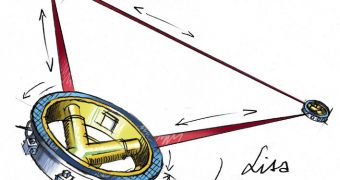The latest decadal report from the National Research Council (NRC) is highly supportive of a new space observatory mission called LISA, which is to analyze the Universe in search for gravitational waves.
Discovering this elusive space phenomenon has thus far been unsuccessful, but experts believe that the Laser Interferometer Space Antenna may have what it takes to get the job done.
The LISA is recommended as one of NASA's next two major space operations. The “Astro2010” report shows that the American space agency should begin work on the observatory with the European Space Agency (ESA), starting in 2016.
The reason why the new telescope would be different from others is that it will be able to detect gravitational waves, which are basically moving ripples in the curvature of space-time.
The basic principle behind LISA is fairly simple – create a constellation of three spacecrafts, that will fly in a triangular configuration, in an Earth-like orbit around the Sun.
The satellites will be in close contact with each others, but the length of the triangle's arms will exceed 5 million miles, several times the distance from the Earth to the Moon.
If gravitational waves exist, then they should force at least one of the LISA spacecrafts to move either closer or farther away from the others.
Changes in the flight course will be rather insignificant. In other words, the satellites will not deviate by more than 10 picometers, or 10 million millionths of a meter. This distance is smaller than the diameter of the smallest atom ever observed.
“We are very pleased with the NRC's recognition of LISA's extraordinary research opportunities in astrophysics and fundamental physics. We are looking forward to unveiling a new window on the Universe by observing thousands of gravitational wave sources,” explains Tom Prince.
He is a senior research scientist at the NASA Jet Propulsion Laboratory (JPL), in Pasadena, as well as a professor of physics at the California Institute of Technology (Caltech), and the US chair of the LISA International Science Team, SpaceRef reports.
“This recommendation and our excellent reputation in the scientific community encourages us a lot,” adds the European chair of the LISA International Science Team, Karsten Danzmann.
“With LISA we will open up an entirely new way of observing the universe, with immense potential to enlarge our understanding of physics and astronomy in unforeseen ways,” the official adds.
“In the past it has sometimes been difficult to get mainstream astronomers to recognize the importance of gravitational wave astronomy. The ranking of LISA is an indication that astronomers are recognizing the opportunities that LISA presents for using gravitational waves to study the universe in a new way,” says Marcia Rieke.
The expert is a University of Arizona astronomy professor, as well as the vice chair for the Astro2010 subcommittee on programs.
A few LISA technical data from ESA are available here.

 14 DAY TRIAL //
14 DAY TRIAL //